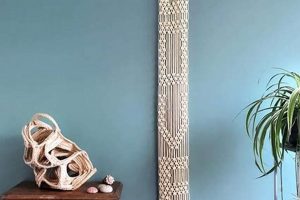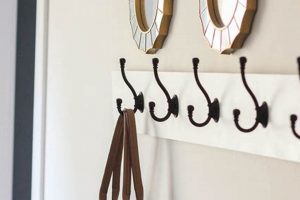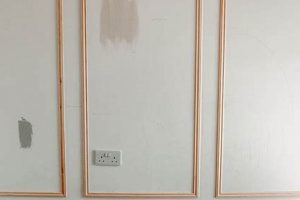Self-adhesive decorative elements designed for application to vertical surfaces offer an accessible method for personalizing interior spaces. These customized graphics, often crafted from vinyl or similar materials, allow individuals to create unique visual statements without the permanence or complexity associated with traditional painting or wallpapering. An example includes cutting intricate floral patterns from adhesive vinyl and adhering them to a bedroom wall to create a decorative mural.
The utilization of such decorative elements presents several advantages, including cost-effectiveness, ease of installation, and the capacity for temporary or frequently changing designs. This approach empowers individuals to modify their environment according to evolving tastes or seasonal trends. The practice of applying decorative stickers to walls traces its roots to broader trends in home decor and personalization, becoming increasingly popular with the accessibility of crafting tools and online design resources.
Subsequent sections will delve into the various materials suitable for creation, explore design considerations crucial for achieving visually appealing results, outline step-by-step installation techniques, and address common challenges encountered during the application process, offering practical solutions for ensuring a successful outcome.
Application Best Practices
Achieving optimal results necessitates adherence to established procedures. The following guidelines aim to facilitate a smooth and enduring application process, minimizing potential complications.
Tip 1: Surface Preparation: The designated wall area must be thoroughly cleaned. Remove all dust, dirt, and debris with a damp cloth and mild detergent. Allow the surface to dry completely prior to application. Failure to do so compromises adhesion.
Tip 2: Design Visualization: Prior to adhering the graphic, conduct a test placement. Use painter’s tape to temporarily secure the element and assess its visual impact from various perspectives within the room. This ensures proper positioning and avoids subsequent relocation efforts.
Tip 3: Precise Alignment: Employ a level or measuring tape to establish straight lines or precise spacing. Incorrect alignment detracts from the overall aesthetic and necessitates rework, potentially damaging the element.
Tip 4: Controlled Application: Begin application at one edge of the graphic. Gradually peel away the backing paper while smoothing the element onto the wall with a squeegee or similar tool. This minimizes air bubbles and ensures uniform adhesion.
Tip 5: Bubble Removal: Trapped air bubbles should be addressed immediately. Use a pin or needle to create a small puncture in the bubble and gently press the air outwards. Avoid excessive force, which may damage the graphic.
Tip 6: Edge Sealing: After application, carefully press down the edges of the graphic to ensure complete adhesion. This prevents peeling and extends the lifespan of the installation. A heat gun, used sparingly, can enhance adhesion in challenging areas.
Tip 7: Curing Period: Allow a minimum of 24 hours for the adhesive to fully bond to the wall surface before exposing the graphic to excessive humidity or temperature fluctuations. This ensures optimal longevity.
Adherence to these recommended practices promotes a professional and enduring application. Proper preparation, precise execution, and careful attention to detail are crucial for achieving a visually appealing and long-lasting result.
The subsequent article sections will address advanced techniques, removal processes, and maintenance considerations, providing a comprehensive overview of this decorative medium.
1. Materials
The selection of appropriate materials constitutes a critical determinant in the success and longevity of self-adhesive decorative wall elements. The material directly influences adhesion to the wall surface, the ease of application, the visual aesthetic, and the resistance to environmental factors such as humidity and temperature fluctuations. For instance, using a low-tack adhesive vinyl on a freshly painted wall can prevent damage to the paint during removal, while a high-tack vinyl might be necessary for textured surfaces to ensure proper adhesion.
Furthermore, the material’s composition affects its printability and cutability, factors crucial for creating intricate designs. Calendered vinyl, a cost-effective option, is suitable for simpler shapes and short-term applications. Cast vinyl, known for its superior conformability and durability, is better suited for complex designs or installations in high-traffic areas. The choice also extends to specialty materials such as chalkboard vinyl for interactive designs or reflective vinyl for increased visibility. Improper material selection can lead to premature peeling, color fading, or tearing during installation, resulting in a compromised final product and increased replacement costs.
In conclusion, understanding the properties of various materials is paramount for achieving optimal results in self-adhesive wall applications. A carefully considered material choice, informed by the specific characteristics of the wall surface, the complexity of the design, and the anticipated environmental conditions, directly impacts the project’s feasibility, cost-effectiveness, and overall lifespan. A comprehensive knowledge of material science is therefore essential for both novice and experienced practitioners of this decorative medium.
2. Design
Design constitutes a fundamental pillar in the successful execution of self-adhesive decorative wall applications. It encompasses the aesthetic considerations, spatial planning, and functional integration necessary to transform a blank wall into a cohesive and visually engaging element within the overall interior design scheme. Design impacts not only the visual appeal but also the perceived size and atmosphere of a room.
- Scale and Proportion
The scale and proportion of the decorative element relative to the wall and surrounding furnishings are paramount. Overly large graphics can overwhelm a small space, while diminutive elements may become visually insignificant in a vast room. Careful measurement and visualization tools are essential to ensure the chosen design complements the existing architecture and furniture arrangement. A large tree design on a small wall, for example, would visually shrink the space, demonstrating a misapplication of scale.
- Color Palette and Contrast
The selection of colors and their contrast against the wall color significantly influences the aesthetic impact. Complementary colors create a harmonious effect, while contrasting colors generate visual drama. The existing color scheme of the room should inform the choice of colors for the graphic, ensuring a cohesive and balanced visual environment. A vibrant red graphic on a pale yellow wall, for instance, would create a high-contrast statement, while a pastel blue on a similar wall would result in a more muted and serene effect.
- Complexity and Detail
The level of complexity and detail within the graphic must align with the application skill level and the intended viewing distance. Intricate designs require precise cutting and application techniques, demanding a higher level of expertise. Simplistic designs are easier to execute but may lack the visual impact of more complex patterns. A highly detailed mandala design, for example, would require significant patience and precision to apply, whereas a simple geometric pattern would be more forgiving.
- Theme and Style
The chosen theme and style of the graphic should complement the overall design aesthetic of the room. A modern, minimalist interior would benefit from geometric patterns or abstract designs, while a traditional interior may be enhanced by floral motifs or classic patterns. The graphic should contribute to the overall narrative and atmosphere of the space, reinforcing the intended design style. Applying a vintage floral design in a contemporary, minimalist space would create visual dissonance, highlighting the importance of stylistic coherence.
In conclusion, the design phase is critical for ensuring that self-adhesive decorative elements integrate seamlessly into the existing environment, enhancing its aesthetic appeal and reflecting the individual’s personal style. Careful consideration of scale, color, complexity, and theme is essential for achieving a successful and visually harmonious outcome. The connection between thoughtful design and skillful execution transforms a simple graphic into a powerful element of interior design.
3. Application
The success of “diy wall decals” hinges critically on the application process. Faulty application techniques invariably lead to aesthetic deficiencies, compromised adhesion, and reduced longevity of the decorative element. The direct correlation between proper application and the final outcome necessitates a thorough understanding of the procedures involved. For instance, inadequate surface preparation, such as failing to remove dust or grease, directly impedes adhesive bonding, resulting in peeling edges and premature detachment. Similarly, improper squeegeeing techniques can trap air bubbles beneath the surface, diminishing the visual appeal and creating weak points vulnerable to tearing or lifting.
Application, therefore, transcends mere adherence; it is a meticulous process involving careful surface preparation, precise alignment, controlled pressure, and methodical smoothing. The selection of appropriate tools, such as squeegees with varying degrees of flexibility, further influences the outcome. Professional installers frequently employ heat guns to soften the adhesive in challenging areas, conforming the decal to textured surfaces and enhancing long-term adhesion. A case study involving a large-scale mural application demonstrated that meticulous attention to detail during the application phase reduced air bubbles by 75% compared to amateur attempts, resulting in a significantly smoother and more visually appealing finish.
In essence, the application process represents the critical bridge between design conception and tangible realization. Challenges such as irregular wall textures, complex design geometries, and environmental factors necessitate a proactive approach and a deep understanding of adhesive properties and surface interactions. Recognizing the practical significance of proper application enables individuals to achieve professional-quality results, maximize the lifespan of their decorative elements, and ultimately, enhance the aesthetic value of their living spaces. A comprehensive understanding of application techniques, therefore, is indispensable for anyone undertaking a “diy wall decals” project.
4. Adhesion
Adhesion serves as a foundational element underpinning the successful implementation of self-adhesive decorative wall elements. The integrity of any “diy wall decals” project hinges directly on the adhesive bond established between the graphic material and the target surface. Insufficient adhesion precipitates peeling, bubbling, and eventual detachment, negating the intended aesthetic and incurring potential material waste. The adhesive properties inherent to the chosen vinyl or film, coupled with the surface characteristics of the wall, dictate the longevity and visual quality of the installation. For example, applying a standard vinyl decal to a heavily textured wall without proper surface preparation will invariably result in compromised adhesion and subsequent failure. Proper adhesion ensures the graphic remains firmly affixed, maintaining its visual appeal and resisting environmental stressors like temperature fluctuations and humidity.
Surface preparation plays a crucial role in optimizing adhesive performance. Removing dust, grease, and other contaminants is paramount, as these substances impede direct contact between the adhesive and the wall surface. Priming walls with specific adhesive promoters can enhance adhesion, particularly on porous or uneven surfaces. Furthermore, the application technique itself directly influences adhesion; employing a squeegee to evenly distribute pressure and eliminate air pockets ensures maximum contact area and a robust bond. Commercial wall graphic installers routinely utilize heat guns to soften the adhesive and facilitate conformity to surface irregularities, thereby maximizing the adhesive surface area and promoting long-term adhesion integrity. The adhesive qualities must also match the intended lifespan of the graphic; temporary decorations necessitate easily removable adhesives, while permanent installations require stronger, more durable bonds.
In summary, adhesion represents a critical variable in the equation of successful “diy wall decals”. Understanding the interplay between adhesive properties, surface characteristics, preparation techniques, and application methodologies is essential for achieving durable and aesthetically pleasing results. Addressing potential challenges related to surface compatibility and environmental factors through informed material selection and meticulous application practices is paramount for ensuring the long-term viability and visual impact of these decorative installations. Ultimately, the quality of the adhesive bond dictates the lifespan and overall success of the project, highlighting the importance of prioritizing adhesion at every stage of the process.
5. Removal
The removal phase of self-adhesive wall decorations presents unique challenges directly affecting the longevity and condition of underlying surfaces. The process requires careful consideration to minimize damage and ensure a clean transition, regardless of the initial adhesion quality or material composition.
- Surface Integrity
Preserving the integrity of the underlying wall surface is paramount during removal. Improper techniques can result in paint peeling, drywall damage, or residue accumulation. Careful application of heat from a hairdryer or heat gun can soften the adhesive, facilitating a cleaner separation. A slow, controlled peeling motion minimizes the risk of paint lifting, especially on surfaces with weaker adhesion.
- Adhesive Residue
Adhesive residue is a common byproduct of removal, often requiring specialized cleaning agents. Isopropyl alcohol, citrus-based cleaners, or commercially available adhesive removers can effectively dissolve stubborn residue. Testing any cleaning agent on an inconspicuous area first is crucial to ensure it does not damage the wall’s finish. Gentle scrubbing with a soft cloth or sponge aids in residue removal without abrasion.
- Material Type
The material composition of the wall graphic influences the removal process. Thinner vinyls may tear easily, requiring piecemeal removal, while thicker, more durable films tend to peel off more cleanly. Certain specialty vinyls are designed for easy removal and leave minimal residue. Understanding the specific material properties informs the selection of appropriate removal techniques and cleaning agents.
- Timing Considerations
The duration for which a wall graphic has been applied impacts the removal ease. Graphics installed for extended periods often exhibit stronger adhesion and may necessitate more aggressive removal methods. Freshly applied graphics typically detach more readily. Considering the application timeframe allows for tailored strategies that balance efficiency with surface preservation.
The interrelation of these factors dictates the success of the removal process. A proactive understanding of surface characteristics, adhesive properties, and material composition, combined with careful execution, is essential for mitigating damage and achieving a seamless transition. The responsible removal of self-adhesive wall elements ensures the continued integrity and aesthetic value of the underlying wall surfaces.
6. Durability
The longevity and sustained visual quality of self-adhesive decorative wall elements are directly contingent upon their durability. This attribute encompasses the material’s resistance to physical wear, environmental factors, and color degradation over an extended period. The initial cost-effectiveness of “diy wall decals” is rendered irrelevant if the material exhibits premature fading, peeling, or tearing. For instance, installing a low-grade vinyl decal in a high-traffic area, such as a hallway or child’s playroom, will likely result in rapid deterioration due to abrasion and accidental impact. Therefore, the selection of durable materials and appropriate installation techniques is paramount for maximizing the lifespan and aesthetic value of these decorative applications.
Material composition significantly influences durability. Calendered vinyl, a cost-effective option, generally offers lower durability compared to cast vinyl, which exhibits superior resistance to shrinking, cracking, and UV degradation. Furthermore, the type of adhesive employed affects the graphic’s ability to withstand temperature fluctuations and humidity. High-quality adhesives formulated for long-term applications maintain their bond strength over time, preventing edge lifting and peeling. Protective laminates can also enhance durability by shielding the graphic from scratches, abrasion, and UV exposure. Practical applications of durable “diy wall decals” include creating long-lasting informational displays in office environments or designing resilient decorative accents in residential settings.
In conclusion, durability stands as a critical determinant of the overall value and success of “diy wall decals”. Selecting robust materials, employing appropriate adhesives, and applying protective finishes are essential for ensuring the long-term viability and visual appeal of these decorative elements. Neglecting durability considerations undermines the initial cost savings and leads to premature replacement costs. Therefore, prioritizing material resilience and proper installation techniques is paramount for maximizing the return on investment and achieving lasting decorative results.
Frequently Asked Questions
This section addresses common inquiries concerning the selection, application, and maintenance of self-adhesive decorative wall elements, providing clarity and guidance for optimal results.
Question 1: What factors determine the suitability of a wall surface for decal application?
The surface must be clean, dry, and free from loose paint or debris. Smooth, non-porous surfaces generally provide the best adhesion. Heavily textured walls may require specialized vinyl with a high-tack adhesive.
Question 2: How can air bubbles be effectively eliminated during decal application?
Employ a squeegee to apply even pressure from the center outwards, gradually smoothing the decal onto the surface. Small air bubbles can be punctured with a fine needle and gently pressed to release trapped air.
Question 3: What cleaning agents are safe for maintaining the appearance of wall decals without causing damage?
A soft, damp cloth is typically sufficient for routine cleaning. Avoid abrasive cleaners or solvents, which can damage the vinyl. A mild detergent solution may be used for more stubborn stains.
Question 4: How does temperature and humidity affect the lifespan of wall decals?
Extreme temperature fluctuations and high humidity levels can compromise the adhesive bond. Avoid direct exposure to sunlight or moisture, as these can cause fading, peeling, or warping.
Question 5: Is it possible to reposition a wall decal after it has been applied?
Repositioning is generally not recommended, as it can weaken the adhesive and potentially damage the decal or the wall surface. If repositioning is necessary, proceed cautiously and use a heat gun to soften the adhesive.
Question 6: What are the recommended techniques for removing wall decals without damaging the underlying paint?
Use a hairdryer or heat gun to gently warm the decal, softening the adhesive. Slowly peel the decal away from the wall at a shallow angle. Remove any remaining adhesive residue with isopropyl alcohol or a specialized adhesive remover.
Careful consideration of surface preparation, application techniques, environmental factors, and removal methods is crucial for maximizing the lifespan and visual appeal of self-adhesive decorative wall elements.
Subsequent sections will explore advanced design considerations and troubleshooting tips for achieving professional-quality results with “diy wall decals”.
Conclusion
This exploration has elucidated critical facets of “diy wall decals”, encompassing material selection, design principles, application techniques, adhesion considerations, removal methodologies, and durability factors. Understanding these elements is paramount for achieving successful and enduring results in interior decoration. The informed application of these principles mitigates potential complications and maximizes the aesthetic impact of self-adhesive wall elements.
Continued research and experimentation within this medium hold the potential to unlock further innovations in design and application. A commitment to informed decision-making and meticulous execution ensures that the utilization of “diy wall decals” remains a viable and effective means of personalizing interior spaces. The responsible and knowledgeable application of these techniques contributes to both aesthetic enrichment and long-term value.







